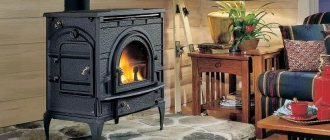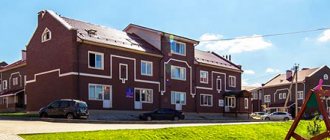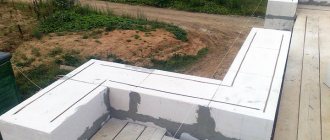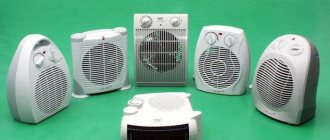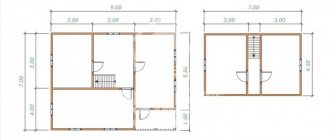Despite huge gas reserves and many pipelines, most small Russian settlements located far from large cities are unlikely to ever be gasified. It's simply not profitable. Even in the heart of Russia, 200 km from Moscow, only those towns and villages that are located no further than 10-15 km from cities are gasified. Then everything is like in the remote taiga. The only difference is that there is electricity.
The climate in Russia is harsh, and our cold season lasts 7-8 months. That is why well-established and inexpensive heating in a private home is a vital living condition. In the absence of cheap gas, two suitable fuel options remain: electricity and all types of solid fuels.
Electricity is a very expensive means of heating a private home, and far from safe, although very convenient. What remains are the good old firewood and their modern analogues: briquettes and pellets. Although they are also becoming more expensive. Who knows, maybe in a couple of years the cost of preparing firewood for the coming winter will be comparable to the cost of electricity and lying on a warm stove in your house, as in Russian fairy tales, will become too expensive.
When building a house, you need to decide what is better to choose for heating: a solid fuel hot water boiler or a brick stove, which is traditionally equipped in many village houses. And in order to make the right decision, you should consider in more detail the pros and cons of both options.
Stove or boiler: differences, pros and cons, how to choose a boiler or stove for a private home:
Selecting heating equipment is a very difficult task. The main difficulty is that people do not even understand the terminology well. For example, many do not understand the difference between a boiler and a stove, while others understand, but do not know how to choose a boiler or stove for their private home or cottage.
What is a stove?
The very first thing that comes to mind when you hear the word “stove” is a Russian brick stove with warm walls, a cooking chamber and a stove bench. It warms you up, cooks dinner, and you can sleep on it. In the old days there were only such stoves. Additionally, they had different shelves and niches where you could dry anything: from crackers to felt boots.
Due to its massiveness and brick walls, a Russian stove accumulates and slowly releases heat. If the house is well insulated, then one kindling is enough to maintain a comfortable temperature inside all day. But that's where the benefits end.
Disadvantages of a brick stove:
- It takes up a lot of space and must be in the center of the house so that all rooms are heated.
- To lay a stove you need a specialist, and good stove makers are in great short supply today.
- It is advisable to build the stove at the same time as the house, since the foundation is poured under it, and the layout is also adjusted to the stove.
But it is too early to conclude that the only solution to the problem of suburban heating in modern conditions is to install a boiler in a private house . There are other stoves - metal ones, according to some criteria they are better than a brick one, but according to others they are worse.
Metal stove compared to brick:
- more compact;
- easier to install - no stove or foundation required;
- can operate in long-burning mode.
However, metal stoves are not able to accumulate heat; they cool down and stop heating as soon as the wood in them burns out. And they are not so colorful and comfortable that they should be placed in the middle of the house, like a Russian stove.
Fuel supply
Pellets are convenient because they can be supplied automatically, thereby achieving more efficient combustion of this type of fuel. However, such a system can only work in tandem with a boiler. The required volume of fuel in the form of pellets is poured into the bunker, which can theoretically be so large that you won’t have to remember to replenish it for several months.
At the same time, it is impossible to organize such a fuel supply for a fireplace, since the pellet capacity of this device is only about 30 kg. Here, organizing the fuel supply involves filling the bunker with pellets manually, which guarantees maintaining heat throughout the day.
What is a boiler?
If the stove heats the air around itself, the boiler heats the coolant. This is the fundamental difference. Typically the coolant is water. A water jacket is built into the firebox, and there is an inlet and outlet for connecting the pipe system that is laid throughout the house. Water is heated in the firebox, begins to circulate through pipes, radiators and heats the house.
Thus, the boiler, especially if there is a pump, can be installed in any room and place, even in a neighboring barn or garage. Boilers are often installed in basements. They do not need a foundation; it is enough to assemble the chimney correctly.
The general requirements for installing solid fuel boiler in a private house are the most feasible: room area - at least 7 m², distance to walls - 0.5 m, good ventilation, base made of non-flammable material, iron sheet in front of the firebox. But problems may arise with the “registration” of a gas boiler in your home.
Installing a gas boiler in a private house is not always possible even if there is a gas pipeline
A gas boiler is the most trouble-free and economical heating equipment, but only if gas has already been supplied to the house and the boiler is already installed. If you want to connect to a gas pipeline running nearby, you will encounter many problems: how to obtain permission, draw up technical specifications and a project, and most importantly, the price of connection causes mute surprise and a decision to abandon such pleasure.
Therefore, even if a gas pipeline runs right through your site, do not rush to buy a gas boiler, first find out how realistic it is to connect to this “golden” pipe.
An electric boiler is also not available to everyone due to its high cost.
Installing an electric boiler in a private home, unlike a gas one, does not depend on anyone but you. No permits or other documents are needed; initially, the money will be spent only on the purchase of the boiler itself. But only wealthy people can afford to heat a house with electricity, and prosperity is not always a constant phenomenon. Electricity is expensive, and in the private sector, tariffs are twice as high. It is not wise to spend your entire salary or pension on heating.
For the above reasons, today solid fuel boilers and stoves are widely used throughout Russia.
A brick boiler is better than a steel one. Why this choice?
Why is a brick boiler better than a steel one? Are there any undeniable advantages? After all, for some reason, people everywhere use purchased metal boilers in their heating systems.
No, not everywhere. Everywhere it’s just the opposite. Especially in old houses - there are brick ovens everywhere. As for new buildings, people really first try to assemble a heating system that seems simpler to them. I did the math with the managers, chose the right solid fuel boiler, installed it, and started it up. And all is well?
But no. It turns out that it needs to be heated almost around the clock, there is too much fuel and the suspicion is growing stronger that you made a mistake in your choice, that the efficiency of this boiler is simply non-existent. In addition, chimneys quickly become overgrown with soot, requiring frequent cleaning.
However, not everyone even admits to themselves their suspicions, praising their choice left and right. But a moment comes when the question arises that something needs to be changed. And first of all, as a rule, the idea comes to install a heat accumulator in addition to the solid fuel boiler.
We will not talk here about the fact that again nothing works, that with the heat accumulator there is no desired effect or it is negligible. Simply because the selected boiler does not develop the required power. In the end they come to the conclusion to replace the boiler with a more powerful one.
But here there is no need to prove anything. If you take a calculator and calculate how much it costs, a 110 kW brick boiler turns out to be much cheaper than a steel boiler of the same power. And not only cheaper, but also much more effective.
Why is it more effective? Because its design allows for the most complete combustion of fuel. And this, accordingly, increases the efficiency of the boiler, since less fuel is needed to generate the same amount of heat if it is completely burned.
But what does incomplete combustion mean? Soot formation is the incomplete combustion of fuel, since one of the components of any hydrocarbon fuel - carbon - does not burn, but remains on the walls of chimneys in the form of soot.
What else is effective? The fact is that the heat exchange of a brick boiler is better. The generated heat passes into the coolant as much as possible, and cooled gases go into the pipe. Cooled to such an extent that still allows sufficient draft to be present.
Thanks to this property, the volume of the water heat accumulator can be significantly reduced. For an average house with a heated area of 100-150 m2, the volume of the water accumulator can be halved, to 1 m3. And this, as a consequence, is another reduction in material costs and saving space in the room.
So, the choice of a solid fuel brick boiler over a metal one is always in favor of the former. Because:
- brick is cheaper. In comparison with any metal boiler of the same power, costs can be more than three times lower.
- brick has a higher efficiency, achieved by the design of the firebox, which ensures complete combustion of the fuel, as well as more efficient heat exchange with the coolant.
- with a brick heat accumulator is cheaper. Since the boiler array also accumulates heat, this heat is transferred to the coolant long after the boiler has been heated and closed.
What is better: installing a boiler or a stove in a private house?
From the definitions of these two different units we can draw the following conclusions:
- If you need to heat a small one-story house or garden hut, consisting of one space without doors, then choose a metal stove.
- If you visit this house occasionally and live in it for seasons, then also choose a stove. The boiler and water heating pipes will freeze in winter without constant heating.
- For a private house with many rooms, 1–3 floors, it is necessary to install a boiler, but subject to permanent residence and daily heating.
- If you have a large country cottage, but you visit it not only from spring to autumn, but also visit it in the winter on weekends and holidays, install a stove in the center, for exoticism you can use a Russian one, and additionally, in the utility room, a boiler with antifreeze in as a coolant. In this case, the stove can heat the most necessary rooms: bedrooms and living room, and the boiler can heat the hall, stairs, billiard room, office, etc.
The last option (stove plus boiler) is the most reliable for any private home, especially if it is large. After all, a supply of heat never hurts. Some people install two boilers in their house, running on different fuels: when one runs out, the heating system is switched to another.
Automatic control
The production of fireplaces and boilers today is the production of technological products equipped with various control options based on software products. At the same time, fireplaces outperform boilers in terms of the breadth of possibilities for their control. Quite often, fireplaces are supplemented with a control panel that provides remote control over these devices. Models with control via a smartphone are also available: turning on, adjusting the temperature, receiving information about the temperature, etc.
How to choose a boiler for a private home?
Criteria for choosing a heating boiler:
- Reliability of the seller and manufacturer, ask for certificates and guarantees.
- Fuel type: coal-fired or wood-burning coal will operate with very low efficiency. Universal ones are more expensive, but special ones, designed for one type of fuel, are more efficient.
- Power: 1 kW per 10 m², but this is for a perfectly insulated house, so a reserve is needed. So, for a house with an area of 100–150 m², it is recommended to take boilers of 20–25 kW.
- Firebox volume: how much fuel needs to be added for maximum efficiency, what size firewood should be. A large, half-empty firebox does not work efficiently; a small firebox may not fit standard firewood.
- The presence of a long-burning mode, automation and other technologies to simplify operation.
- Dimensions and design features: make sure that the boiler will fit into doorways, the water inlet/outlet, the chimney are located in the right place, the fire door opens in a convenient direction, there is a hob, etc.
- Weight: how many movers will be needed to deliver to the location.
Despite the differences between a boiler and a furnace, furnaces are selected according to approximately the same criteria. The requirements for installing a boiler and stove in a private house are also the same and are aimed at ensuring fire safety. And one more nuance, no matter how progressive the design of your boiler or furnace is, there will be no good heat if you use bad fuel.
Features of operation
All long-burning stoves are supplied with instructions, but they often do not mention some nuances that must be taken into account:
- It is necessary to provide free space around the stove and protection from fire;
- for easy maintenance (cleaning), the chimney should have a collapsible design if possible;
- pipes must be installed in the direction of gas movement;
- due to low draft, the chimney should not have a curved shape;
- During operation, condensation may form in the chimney.
It should also be noted that liquid fuel cannot be used in long-burning stoves; some models are quite difficult to set up and require constant supervision.
Work order
You can make the equipment yourself or buy a factory unit.
When installing yourself, it is important to consider the following points:
- First, the heat exchanger is prepared;
- Then the circuit is mounted and connected to the thermal boiler;
- Before building a furnace, a pit is dug, then a layer of crushed stone and broken brick is made in it (the foundation should be 2-3 cm higher than the floor level);
- The furnace structure is being erected.
Do you need electricity?
The system can be implemented in two versions:
- Free circulation when heating occurs by gravity;
- Forced way.
In the latter case, a pump and a battery will be required (provide uninterrupted power supply). At first glance, this is convenient: after all, stability is maintained. You can heat not only the first floor, but also other floors.
However, such components significantly increase the cost of stove heating; the design itself acquires impressive dimensions.
What pipes are needed?
Instead of radiators, pipes (80-120 mm in diameter) are usually used. They are better suited for stoves (provide sufficient water volume in the system).
The main thing here is to choose the right material:
- Stainless steel;
- Metal-plastic;
- Polypropylene.
On a note! For brick stoves heated by wood, the best option is steel. It can withstand high temperatures (up to 100 Cº or more). Other materials are not designed for this load (maximum 95 Cº).
Creating a heating wiring diagram
You can combine a stove with a water heating boiler and connect the circuit to the heating system using two schemes.
Open system
With an open system, the expansion tank is located at the highest point - in the attic; you can include a pump in the circuit
The coolant moves by gravity, so the installation of a circulation pump is required. It is placed on the bypass, reduces the temperature difference between the return and supply, increases the speed of water movement and the quality of heat transfer. Without electricity, the line will operate on the principle of gravity.
To organize it, you will need to increase the line and horizontal slopes in diameter. The open system is equipped with a 32 mm distribution manifold with a slope of 3 to 5 mm per linear meter. The expansion tank is located at the top; air enters it from the communications.
Closed system
The radiator network provides for forced movement of water. The thrust in this case is created by a pump. It also pumps up pressure from 1 bar for cold coolant. The membrane-type reservoir is located at the bottom. A shut-off valve is used to connect it to the main line. Safety devices (air vent, pressure gauge, drain valve) are required.
Manufacturers
Currently, on the Russian market you can find a large number of different models of cast iron gas boilers, which are produced by different manufacturing companies. Let's look at the most popular of them.
Ariston (Italy)
Gas boiler with cast iron heat exchanger Ariston Unobloc
The Ariston company produces atmospheric gas cast iron boilers of the Unobloc series. They are well suited for domestic operating conditions, are reliable and have a long service life. The efficiency of the devices is high, reaching up to 90%. The model range is represented by devices with power from 24 to 64 kW.
The cast iron heat exchanger is not subject to corrosion processes and various thermal stresses. The atmospheric burner includes electric ignition and ionization flame control. Ariston boilers, whose power varies from 24 to 31 kW, include a circulation pump, an expansion tank, a safety valve and a minimum pressure switch.
Thanks to the large variety of units made in a variety of design solutions, everyone can choose a heating device that will not only become a source of heat, but will also fit perfectly into the interior.
Baxi (Italy)
Models of floor-standing gas boilers with a cast iron heat exchanger Slim from Baxi got their name due to their small dimensions (width is only 35 cm). In this regard, they can be placed in any room, even the smallest. The manufacturer offers units with atmospheric and inflatable burners. Power ratings range from 15 to 62 kW.
During the operation of boiler equipment, continuous electronic modulation of the flame occurs both in heating mode and in hot water supply mode. These Baxi cast iron boilers are highly safe; they are equipped with an electronic self-diagnosis system, ionization flame control, a protective thermostat against overheating of the liquid in the primary heat exchanger, as well as a draft sensor to control the removal of combustion products.
If your boiler room is quite large and you need a more powerful boiler, then Baxi offer a range of units with an atmospheric burner, the power of which ranges from 83 to 116 kW. The boilers are very well adapted for operation in Russian conditions.
Gas floor-standing boiler Baxi SLIM
Electrolux (Sweden)
Floor-standing gas boiler Electrolux FSB 50 Mi
Electrolux cast iron heating boilers are represented by the FSB series, which includes both single-circuit and double-circuit devices with natural removal of combustion products.
Due to the fact that production is carried out using the most modern technologies, the devices have a long service life and are very economical in fuel consumption.
It is worth noting that Russian cast iron gas boilers are not much inferior to their European counterparts in their technical and operational characteristics and are also very popular among users.
Thanks to a sectional cast iron heat exchanger made using Drop Stop technology, an Electrolux gas boiler can operate successfully for 25-30 years.
Lemax (Russia)
The Russian gas floor-standing boiler with a cast iron heat exchanger Lemax can operate in heating systems with pressure up to 4 Atm.
The wall thickness of the heat exchanger is 4 mm, so it is very durable. There are two types of units in this category - Leader and Wise.
Gas boiler Lemax Leader
The Lemax Leader gas boiler has the following technical characteristics:
- it is non-volatile;
- power 16-50 kW;
- high productivity, efficiency reaches up to 90%;
- the package includes: overheating protection, traction sensor;
- the maximum water temperature is 80°.
The temperature control is located on the front part, there is a pressure gauge nearby, and it is also possible to connect a room thermostat. Thanks to this, you can set the desired temperature in the room, which will be maintained at the same level.
Gas boilers of the Wise series are connected to the electrical network and consume 7 W/hour. They have an uninterruptible power supply installed, so voltage drops will not affect the operation of the units in any way.
Gas boiler with cast iron heat exchanger LEMAKS WISE
User reviews of cast iron gas boilers indicate that these heating devices cope well with their main task - heating, and a wide range of models allows everyone to choose the device that will be the best option.
Calculation and design of the heating system
The main principle of calculation is that the heating system must compensate for the heat loss of the house. Therefore, first of all, heat losses are assessed, on the basis of which the power (kW) that will be required to heat the house is determined. It is impossible to perform such a complex thermal engineering calculation on your own. If it is not possible to entrust the calculation to engineers, you can try to perform it using special programs: Auditor OZC 6.9, nanoCAD otoplenie, VALTEC H2O. Or you can trust the practical experience of heating engineers and assume that for every 10 m2 of area of a heated building, 1.2-1.5 kW of heating power is required. Based on the calculations, a drawing of the heating system is made, which indicates the location of all elements and the movement of the coolant.
Design and installation nuances
Stove heating is a potentially dangerous system, so special attention should be paid to its design and proper installation.
What should you pay attention to when drawing up a project?
Typically, a stove heating scheme is developed simultaneously with a construction project, since it is closely related to the layout of the premises. The location of furnaces should, if possible, be carried out in the area of internal walls. Access to the combustion part should not be hampered in any way and it is best that it can be approached from the corridor.
Particular attention should be paid to the fire safety of the system. Since a common cause of fire is excessive heating of wooden parts, an air gap or indentation must be left between the stove and wooden partitions
Also, the surface of a combustible structure can be lined with bricks or so-called cuttings can be arranged - insulating structures made of fire-resistant materials.
Preparation for installation of the stove begins with strengthening and thermal insulation of the area of the floor on which it will be installed. When installing a stove weighing more than 750 kg, a special foundation must be installed for it. It must be taken into account that the design differs from the traditional foundation for a house, from which it must be separated by a 50 mm wide gap filled with sand.
The stove model is selected taking into account the size and configuration of the room in which it will be installed. Brick layout options can be found in special reference books or on the Internet. The hydronic heating part of the system is designed in the same way as any traditional hydronic structure.
Installation features
As practice shows, a water heating stove can be installed in two ways:
- Design and fold for a specific register.
- Install a heat exchanger into an existing furnace.
The second option is considered the most time-consuming and complex. It involves dismantling the existing structure, installing a carefully sized register and re-installing the structure. The process may be complicated by the need to replace worn-out elements.
In any case, the thickness of the so-called “water jacket” should not be less than 4 cm, otherwise the water may begin to boil. This rule is especially relevant for systems with natural circulation; when installing a pump, the danger of boiling is reduced.
Stove heating with a water circuit is a successful variation of the traditional heating system
Building a country house with stove heating is quite simple. Properly designed and installed equipment guarantees long and trouble-free operation. Stove heating with coolant is considered especially successful, which is everywhere replacing traditional stove heating. Such a practical, economical and effective solution will provide warmth and comfort in your home.
Oil radiator from MS-140 battery
As a rule, oil heaters are used as additional heat sources if the central heating “cannot cope” in full. Sometimes they are used to heat small rooms where heating is not installed.
In this case, knowing how to make an oil radiator from a cast iron battery, you can save a lot on both the purchase of a new device and its operation.
Depending on the power required from the heater, its manufacture may require from 1 to 4 heating elements. As a rule, one or two heating elements are enough to use such an oil radiator in everyday life. To work you will need:
- Classic cast iron battery, for example, brand MS-140.
- Heating element of suitable power.
- Technical oil, but according to craftsmen, the best option would be to use electrical oil, which is poured into transformers. It is resistant to high temperatures and therefore safer. The only drawback of transformer oil is its high cost.
The modern market of thermal technologies offers heating elements specially adapted to work in the MS-140 cast iron radiator. It is better to look for and buy a ready-made device than to try to calculate on your own what power, shape and size of the device will be required.
It is very easy to make an oil cooler by following the steps in the right sequence:
- The heating element is installed in the lower manifold of the cast iron battery from the end part.
- The rear wall of the structure is grounded.
- Move the oil drain hose and ball valve downwards. This is important because if the media drains, the heavy battery case filled with oil may be difficult to tilt.
- A plug is placed on the upper end hole above the heating element, and the hole above the tap is closed with a plug with a Mayevsky tap.
When heated, oil expands greatly and will require space inside the cast iron radiator, so fill the container only 80-85%.
Assembly of the structure
Assembling the radiators together is not difficult, but you should first purchase new intersection gaskets or use instead an asbestos cord impregnated with graphite powder, previously diluted in drying oil.
Since the temperature inside the boiler can exceed +600 degrees, it is worth taking care of the gaskets in advance. The tightness of the entire structure depends on their quality and strength.
The radiator assembly sequence is as follows:
- Nipples equipped with right and left threads are screwed into each section.
- Asbestos cords are wound around them.
- The sections are connected in pairs by alternately tightening the nipples. It is important to make the same number of turns with the key so as not to cause distortion.
- All sections of the cast iron radiator are connected in the same way.
- The return and supply pipes should be connected diagonally, closing unused holes with plugs.
On one side of the riser there should be a right-hand thread, and on the other, a left-hand thread. If this does not work out, then you need to screw on the nipple and the coupling with the drive on it.
